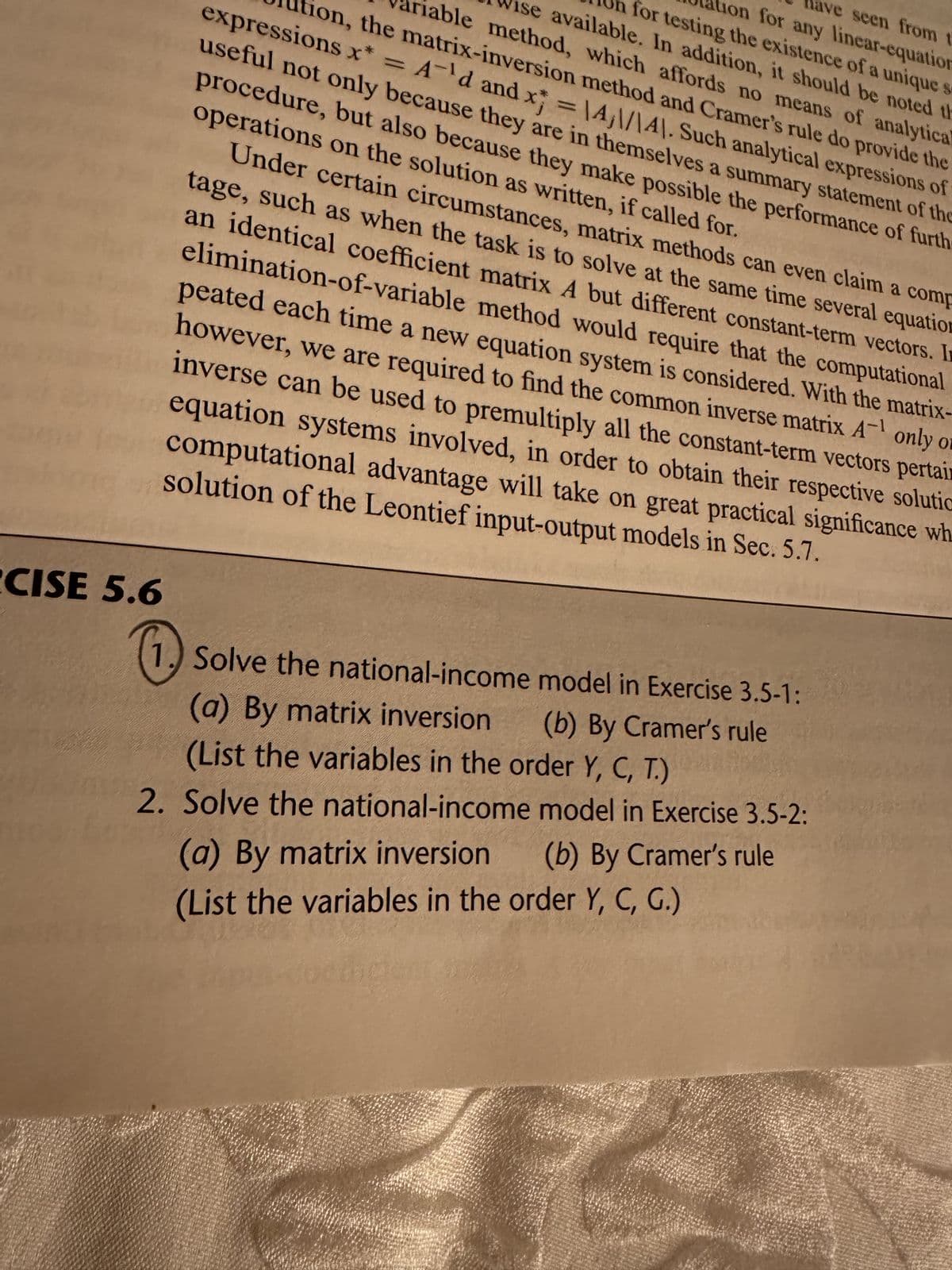Chapter1: Making Economics Decisions
Section: Chapter Questions
Problem 1QTC
Related questions
Question
Solve Y=C+1o+Go, C= a+b(Y-T), T= d+tY using matrix inversion, and again by using Cramer's Rule

Transcribed Image Text:CISE 5.6
0
ave seen from t
tion for any linear-equation
for testing the existence of a unique
ise available. In addition, it should be noted th
iable method, which affords no means of analytical
tion, the matrix-inversion method and Cramer's rule do provide the
expressions x* = A'd and x = 14,\/\4). Such analytical expressions of
operations on the solution as written, if called for.
useful not only because they are in themselves a summary statement of the
procedure, but also because they make possible the performance of furth
Under certain circumstances, matrix methods can even claim a comp
tage, such as when the task is to solve at the same time several equation
an identical coefficient matrix A but different constant-term vectors. In
elimination-of-variable method would require that the computational
peated each time a new equation system is considered. With the matrix-
however, we are required to find the common inverse matrix A¹ only or
inverse can be used to premultiply all the constant-term vectors pertain
equation systems involved, in order to obtain their respective solutic
computational advantage will take on great practical significance wh
solution of the Leontief input-output models in Sec. 5.7.
Solve the national-income model in Exercise 3.5-1:
(a) By matrix inversion (b) By Cramer's rule
(List the variables in the order Y, C, T.)
2. Solve the national-income model in Exercise 3.5-2:
(a) By matrix inversion (b) By Cramer's rule
(List the variables in the order Y, C, G.)
fo
![E 3.5
As a check on our calculation, we can add the C* expression in (3.25) to (To+Go) and
verify that the sum is equal to the Y* expression in (3.24).
This model is obviously one of extreme simplicity and crudity, but other models of
national-income determination, in varying degrees of complexity and sophistication, can
be constructed as well. In each case, however, the principles involved in the construction
and analysis of the model are identical with those already discussed. For this reason, we
shall not go into further illustrations here. A more comprehensive national-income model.
involving the simultaneous equilibrium of the money market and the goods market, will be
discussed in Sec. 8.6.
C
1 Given the following model:
Y = C + lo + Go
C = a + b(Y - T)
T=d+tY
(a>0,
(d>0,
Chapter 3 Equilibrium Analysis in Economics 47
0<b<1) [T: taxes]
0<t<1) [t: income tax rate)
(a) How many endogenous variables are there?
(b) Find Y*, T*, and C*.
income model be:](/v2/_next/image?url=https%3A%2F%2Fcontent.bartleby.com%2Fqna-images%2Fquestion%2F18def6ce-9aea-4bab-b8da-98b00690cf31%2Ff2d677a6-2972-4cea-8d1e-8228267c2976%2F5g65n2yn_processed.jpeg&w=3840&q=75)
Transcribed Image Text:E 3.5
As a check on our calculation, we can add the C* expression in (3.25) to (To+Go) and
verify that the sum is equal to the Y* expression in (3.24).
This model is obviously one of extreme simplicity and crudity, but other models of
national-income determination, in varying degrees of complexity and sophistication, can
be constructed as well. In each case, however, the principles involved in the construction
and analysis of the model are identical with those already discussed. For this reason, we
shall not go into further illustrations here. A more comprehensive national-income model.
involving the simultaneous equilibrium of the money market and the goods market, will be
discussed in Sec. 8.6.
C
1 Given the following model:
Y = C + lo + Go
C = a + b(Y - T)
T=d+tY
(a>0,
(d>0,
Chapter 3 Equilibrium Analysis in Economics 47
0<b<1) [T: taxes]
0<t<1) [t: income tax rate)
(a) How many endogenous variables are there?
(b) Find Y*, T*, and C*.
income model be:
Expert Solution
This question has been solved!
Explore an expertly crafted, step-by-step solution for a thorough understanding of key concepts.
This is a popular solution!
Trending now
This is a popular solution!
Step by step
Solved in 6 steps with 20 images

Knowledge Booster
Learn more about
Need a deep-dive on the concept behind this application? Look no further. Learn more about this topic, economics and related others by exploring similar questions and additional content below.Recommended textbooks for you


Principles of Economics (12th Edition)
Economics
ISBN:
9780134078779
Author:
Karl E. Case, Ray C. Fair, Sharon E. Oster
Publisher:
PEARSON

Engineering Economy (17th Edition)
Economics
ISBN:
9780134870069
Author:
William G. Sullivan, Elin M. Wicks, C. Patrick Koelling
Publisher:
PEARSON


Principles of Economics (12th Edition)
Economics
ISBN:
9780134078779
Author:
Karl E. Case, Ray C. Fair, Sharon E. Oster
Publisher:
PEARSON

Engineering Economy (17th Edition)
Economics
ISBN:
9780134870069
Author:
William G. Sullivan, Elin M. Wicks, C. Patrick Koelling
Publisher:
PEARSON

Principles of Economics (MindTap Course List)
Economics
ISBN:
9781305585126
Author:
N. Gregory Mankiw
Publisher:
Cengage Learning

Managerial Economics: A Problem Solving Approach
Economics
ISBN:
9781337106665
Author:
Luke M. Froeb, Brian T. McCann, Michael R. Ward, Mike Shor
Publisher:
Cengage Learning

Managerial Economics & Business Strategy (Mcgraw-…
Economics
ISBN:
9781259290619
Author:
Michael Baye, Jeff Prince
Publisher:
McGraw-Hill Education